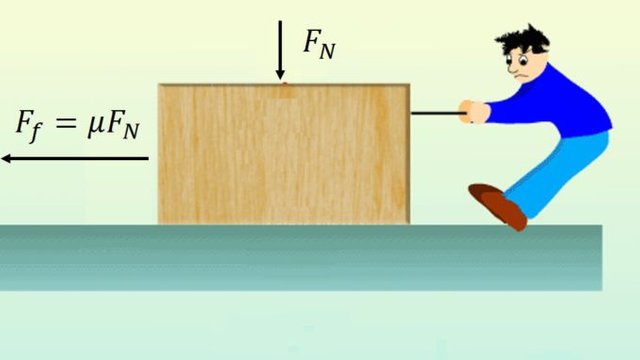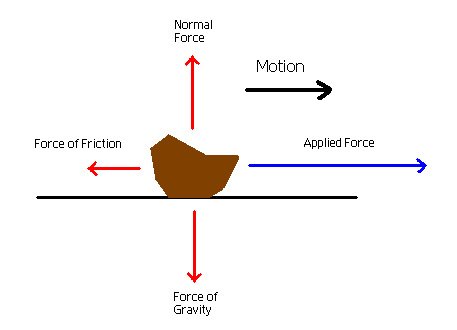Physics - Classical mechanics - Contact forces and friction
Hello it's a me again drifter1! Today we continue with the Classical mechanics branch of Physics by getting into contact forces and friction. I already talked a little bit about friction in my post about Newton's 3rd law. Knowing the 3rd law will be pretty important for contact forces and so I suggest you to check it out if you haven't already! So, without further do, let's get started!
Small recap
In my previous posts we covered Newton's laws.
The first and second law cover the motion of an object.
When the total force applied it zero then the object keeps it's current state and either stays at rest or moves with a constant velocity, cause we have zero acceleration. (1st law)
When the total force is not zero then the object has a acceleration and we use the equation:
F = m a (2nd law)
Note that an object might have a different kind of motion for each of the component vectors for the axes and so we might use both of these laws on the same object!
Lastly, the 3rd law tells us that for each action there is always a reaction. This means that when we apply a force to an object this object applies the same (opposite) force to us. The sum of those two forces is zero and not the total force applied to us or the object! (but it can be if other forces also are in the game)
So, let's now get into contact forces.
Contact Forces
When two objects interact directly through contact, then the interaction forces are contact forces.
The two most important contact forces are:
- vertical forces (that the ground applies to us when we stand on it for example)
- friction (that causes slip and slide that slow us down)
Let's get into each of these more specifically.
Vertical force (N)
When an object is at rest or slides, and so is on top of a surface it applies a force equal to it's weight (exactly the weight if it a horizontal plane, the vertical component to the surface when on a slope) to that surface. Because of the 3rd law we know that the surface also applies the same force back to the object.
We call this force N and this force is parellel to the "slip" surface.
From that you can clearly see that the vertical force and friction will always be perpendicular to each other (will have a 90 degree angle to each other).
So, N is not so difficult to be calculated, cause we just have to find the right vector component of the object's weight and set it equal to N, because the object stays at rest on that vertical axis and so Newton's 1st law applies.
But, what about friction?
Friction
Well, friction has a connection to the vertical force N.
I already told you last time that the friction is equal to:
T = μ*N
where T is the friction, μ is the surface "slip" factor and N is the vertical force.
From that we can see that we will need more force when the vertical force is larger and so the object "weight's" more. We will also need less force when the surface is more "slippy", which means that μ is close to zero.
There are two types of friction:
- kinetic friction (Tk) that is applied when the object is moving
- static friction (Ts) that is applied when the object is at rest
The kinetic friction is equal to:
Tk = μk * N
where μk is the factor of kinetic friction.
Kinetic friction is always the same when the object is moving!
Of course the object doesn't slope on it's whole surface, and the surface will also not be exactly the same, but we suppose that this doesn't need to be calculated! We just estimate by using the "perfect" scenario!
The static friction is:
Ts <= μs * N
where μs it the factor of static friction.
Static friction shows us how much force we have to apply until the object starts moving on a surface. This means that the static friction might also be zero, when no force is applied.
μs * N is the maximum value of static friction that we can have.
At that exact moment where we surpass it we start getting kinetic friction.
So, while the object doesn't move, when applying force to it the 1st law is true and so ΣF = 0.
There we can calculate the static friction factor.
The static and kinetic friction factors are not equal (but they can be).
The first one is mostly bigger and so we have to apply a little more force to make an object start moving then keeping it in motion!
An interesting diagram is this:
You can see that the applied force from the object to us (friction) is first growing and after the object starts moving we see a decrease in that force and the friction stays then almost the same!
Something worth mentioning is that we also have other type of friction, like the friction that a rotating wheel has The friction Tr with a factor μr is much smaller then the other frictions and that's why we use wheel's for vehicles etc. to have the least amount of friction possible!
Image Sources:
And this is actually it for today! I hope that you enjoyed it!
Next time we will get into the Dynamics of Circular Motion!
Bye!



This is a test comment, notify @kryzsec on discord if there are any errors please.
Being A SteemStem Member
thanks for the post! interested
Awesome intro to friction :)
One thing I never understood was WHY kinetic friction is always less than static friction? Like, why is that a thing?
Friction occurs between two rough surfaces. Be sure that if there are perfect surfaces, there will be no friction. The item you use is as heavy as you want.
link
In the kinetic friction, rough surfaces feel less irregularity as they slide over each other. It can even be calculated mathematically by taking the RMS value of the roughness field. This is given as a friction coefficient. However, more effort is needed to move a stationary object. The reason for this is that the coefficient of friction is higher in stationary bodies.
You can do a little experiment right away. Try to push a heavy object in a roughly place. You will feel that you can move the object more easily when you perform the move the object.
Beautiful explanation :)
Thank you...
That's awesome man! That diagram helps visualise too! Thanks for answering that question
Not at all;)
Hi, i love physics and if i see these kind of simple applications in daily life, i am excited more.
For static and kinetic friction i can give a good daily example. Everybody knows the ABS mechanism for the vehicle. The mechanism exactly uses these two friction. Long long year ago when you break the vehicle the break system just lick the wheels and vehicle starts to slide and them stop. However ABS mechanism started the use static friction more efficiently. How? When you push the breaks of the vehicle, the system gives pulsed break (it means that lots of static friction) and uses much more friction then fully breaks which uses kinetic friction.
Thank you to post such a good info. Have a curious day...
Thank you and nice example!
By seeing all these laws of physics actually being useful in common everyday problems, my love for physics gets even stronger.
I agree with all my heart..
Ahh friction.. that force that prevents us from moving but that whitout we can't do a lot of things. Good post!